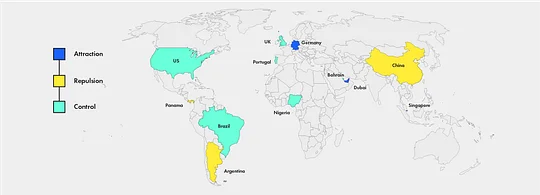What does the future hold for crypto regulation?

Crypto is more than just the next shiny thing. It’s a new transactional infrastructure enabling use cases that were previously impossible, while disintermediating established players across markets.
Some of these regulations will continue to make sense as crypto becomes increasingly more mainstream. Some won’t.
The three major factors currently standing in the way of broader crypto adoption are:
Education
User experience
Regulatory integration
Don’t worry, we’ll get to education and UX in further pieces. But what’s hot right now is how countries are - each in their own way - speaking about, preparing for, and even acting towards regulating crypto.
We’ve largely seen three different approaches emerge globally in recent history. This has created what regulators dread the most: regulatory arbitrage. This is when companies or individuals move around the world to find a jurisdiction where the rules are more sympathetic to their activities - taking the capital, resources, and prosperity to greener pastures.
We’ve largely seen three different approaches emerge globally in recent history.
The three approaches are:
Attraction
Repulsion
Control
With attraction, the jurisdiction works alongside industry participants - exchanges, DeFi protocols, VC funds, etc. - to create a regulatory framework coexistent with traditional regulation, while catering to the specific needs of those entities.
With repulsion, the jurisdiction works against the industry participants. It does this by creating a regulatory framework that prevents companies and individuals from accessing the products and services provided by crypto projects and companies.
With control, the jurisdiction allows crypto companies to operate, but it creates a control framework. This usually involves new forms of taxation, allowing access to crypto products and services. At the same time, it penalises the crypto companies and their users with high regulatory observance costs and taxes.
Here are some examples of each approach around the world:

Created by 11:FS, based on Thomson Reuters' Cryptocurrency regulations by country
Regulatory integration is a critical part of taking crypto mainstream
Although it’s helpful to separate these different stances in the interests of analysis, there are other nuances to each. Some countries treat cryptocurrencies as money, while some see them as securities. Some care about the taxes over capital gains, while others tackle taxes in the context of trading income.
While all of these are valid approaches that suit each country’s realities and understanding (or lack thereof) of crypto, they do create the space for regulatory arbitrage. So we had this wild idea that the best way to solve this is regulatory integration.
What we mean by this is:
Jurisdictions working in an integrated manner
Regulators participating on-chain
Integrating the work from jurisdictions sounds obvious, but it’s anything but easy. The work of entities like Global Digital Finance (GDF) and Global Blockchain Business Council (GBBC) is instrumental in helping countries come together and think about these challenges. They even take local characteristics - cultural, economic, etc. - into account.
Integrating the work from jurisdictions sounds obvious, but it’s anything but easy.
Participating on-chain is the ultimate form of integration. This means that regulators must do at least two things:
On-chain reporting and analysis
Regulated smart contracts
On-chain reporting and analysis
Most regulators monitor the market with extensive amounts of data, which is collected internally by the regulated entities, processed, adjusted, formatted, and then submitted to the regulatory reporting system. This can take anywhere from 15 to 90 days, depending on the type of report being filed. So the process is slow, prone to errors, and expensive, both to the regulators and entities.
In crypto, all activity is recorded on the underlying blockchain, making the data for reporting and analysis available in near real-time. As a matter of fact, companies such as Elliptic, Sardine, Chainalysis, and Dune are building those capabilities and turning them into a new market.
This design principle also means that regulators can participate in the market in near real-time by monitoring activity, drawing insights, and acting as these things happen, gaining a competitive edge currently unavailable to most regulators.
If you’re a regulator, imagine being able to draw (almost) immediate insights into how your regulated entities (and clients) are performing; an always-on market monitor.
Had the technology been implemented in time, the 2008 CDS/mortgage-backed securities crisis could’ve been minimised, or even prevented altogether.
Regulated smart contracts
Now just imagine that not only do blockchains let you monitor things you could (maybe) only access weeks after in real-time, but they also allow you to be present even before transactions happen. How? By directly helping the development of innovation in the industry.
The idea of regulated smart contracts is that, as regulators are integrated into on-chain activity, they can start to provide Software Development Kits (SDKs) that are audited and in compliance with regulations. This means that regulated entities, such as banks, fintechs, and other startups, can use these SDKs to build smart contracts that are regulated by design. They’ll not only function how the regulations require them to, but will also prevent any particular misbehaviour from ever happening. Think of these as safeguards against widespread systemic risk.
This is a far cry from the role regulators play today with regards to traditional finance infrastructure. You won’t see a Central Bank coding a portion of HSBC’s lending application on their mainframe. But with crypto, the infrastructure is public and the code is open, enabling closer collaboration between regulators and the industry, to further innovation with the proper degree of risk-taking.
This is a far cry from the role regulators play today with regards to traditional finance infrastructure.
Regulatory integration is a pretty crazy idea. It will completely reposition the role of the regulators in relation to the markets, but it is a generational opportunity to enable a completely new level of innovation.
How web3 is shaping the future of finance
Download our report that covers the world of web3, including tokens, Stablecoins, DAOs, wallets and more. It's a must-read for the crypto-natives and crypto-curious.
Find out more



